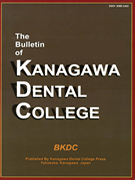- HOME
- > 一般の方
- > バックナンバー:The Bulletin of Kanagawa Dental College
- > 37巻2号
- > アブストラクト
アブストラクト(37巻2号:The Bulletin of Kanagawa Dental College)

English
| Title : | Characterization of Fluoridated Apatite-Coated Titanium Dioxide Photocatalyst |
|---|---|
| Subtitle : | ORIGINAL ARTICLES |
| Authors : | Tomofumi Sawada*1, Tomoji Sawada*2, Yusuke Takahashi*3, Takeshi Shibata*1, Shusaku Okada*4, Noriyuki Hoshi*1, Nobushiro Hamada*3, Toshio Teranaka*4, Katsuhiko Kimoto*1, Minoru Toyoda*2 |
| Authors(kana) : | |
| Organization : | *1Division of Fixed Prosthodontics, CDepartment of Oral and Maxillofacial Rehabilitation, Kanagawa Dental College, *2Division of Removal Prosthetics, Department of Oral and Maxillofacial Rehabilitation, Kanagawa Dental College, *3Division of Microbiology, Department of Infection Control, Kanagawa Dental College, *4Division of Restorative Dentistry, Department of Oral Medicine, Kanagawa Dental College |
| Journal : | The Bulletin of Kanagawa Dental College |
| Volume : | 37 |
| Number : | 2 |
| Page : | 111-116 |
| Year/Month : | 2009 / 9 |
| Article : | Original article |
| Publisher : | Kanagawa Odontological Society |
| Abstract : | [Abstract] Fluoridated apatite coated-titanium dioxide (FAp-TiO2), a multifunctional photocatalytic material, was synthesized, and then used to improve the acid resistance of hydroxyapatite-coated TiO2 (HAp-TiO2). Because there is insufficient information available on the photocatalytic effect of FAp-TiO2 in comparison to HAp-TiO2, the characterization of FAp-TiO2 has not yet been clarified. In order to establish a new denture cleaning method that uses acrylic denture base resin containing FAp-TiO2, we investigated the solubility of FAp-TiO2 and evaluated its photocatalytic effects by measuring the decomposition of methylene blue (MB) and the viability of Candida albicans. In the solubility test, FAp-TiO2 initially inhibited the solubility of calcium as compared to HAp-TiO2. The decomposition of MB decreased significantly in FAp-TiO2 as compared to that in Hap-TiO2 (p<0.01). Furthermore, the cell viability of C.albicans decreased significantly in FAp-TiO2 as compared to that in Hap-TiO2 (p<0.01). These results indicated that FAp-TiO2 had superior acid resistant properties and exhibited greater photocatalytic activity than HAp-TiO2, suggesting the possibility for the extensive use of FAp-TiO2 as a novel photocatalyst material, and its application in the field of dentistry. |
| Practice : | Dentistry |
| Keywords : | Titanium dioxide (TiO2), Photocatalyst, Fluoridated apatite, Acid resistance, Candida albicans |
